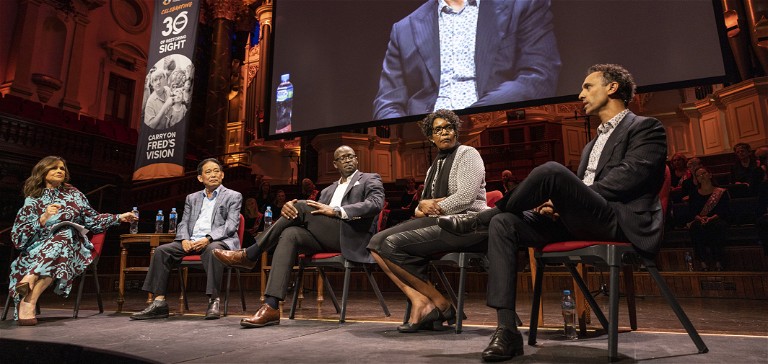
The Fred Hollows Foundation
Celebrates 30 Years
of Restored Sight
Photograph by Michael Amendolia.
“When you get someone who says we’re going to end cataract blindness in the world – that’s 35 plus million people – you think, ‘yeah, dream on Fred’”
The Fred Hollows Foundation has celebrated its thirtieth anniversary, and the restoration of sight for more than three million people from around the world via cataract and trachoma surgeries. The Foundation has also trained surgeons and community health workers, provided screening programs, equipped facilities, and distributed glasses, among other sight-saving interventions.
At a packed Sydney Town Hall on 30 August, media identity Lisa Wilkinson engaged in conversation, as Master of Ceremonies, with broadcaster Ray Martin (a life member of The Foundation) and Dr Cam Hollows (son of Fred and Gabi Hollows). She then led a panel discussion about The Foundation’s current work with guests Dr Kris Rallah-Baker (Australia’s first and only First Nations ophthalmologist), Jane Ohuma (The Foundation’s Country Manager, Kenya, Rwanda and Burundi), Kelvin Storey (The Foundation’s Director of Global Program Implementation) and Dr Phuc Huynh Tan (The Foundation’s Director of Program Implementation for Asia).
Unfortunately, Gabi Hollows was unable to attend the evening as she had COVID.
PAYING TRIBUTE TO KEY PLAYERS
Paying tribute to key players in the early years, Ray Martin highlighted Fred Hollows’ ‘big picture thinking’ which led to The Foundation’s establishment. “When you get someone who says we’re going to end cataract blindness in the world – that’s 35 plus million people – you think, ‘yeah dream on Fred’, but it’s that sort of big picture stuff – and now we have colleagues from overseas who are seeing the result of this extraordinary dream he had.”
He described Gabi Hollows, who trained and worked as an orthoptist, as the “sense and sensibility of the organisation” keeping everyone on track, and he said there would not have been a Fred Hollows Foundation without the first CEO, Mike Lynskey.
Mr Martin acknowledged the support of Ita Buttrose, but said it was a surprise donation of one million dollars from Australian entrepreneur and philanthropist Dick Smith, that enabled The Foundation to survive and later thrive when, six years into its operation, it had run out of funding.
Dr Cam Hollows paid credit to Ray Martin, saying that his close friendship with Fred “helped to put the organisation on its feet”… and ensured it “remained engaged with Indigenous Australian affairs”.
He also acknowledged individuals who have more recently worked to establish sound governance and structures for The Foundation and contributed to planning.
Due to this he said, “We have been able to weather COVID so extraordinarily well because… of the hard work of individuals at (both) in-country and board level”.
FOUNDATION ACHIEVEMENTS
Turning to The Fred Hollows Foundation’s achievements, Dr Hollows highlighted the flow-on results of its investment in delivering eye health services. When people lose sight, they lose their independence and rely on others (most often daughters or granddaughters) to help them. This removes the young person from school or work.
“If we can liberate that girl by fixing grandma’s eyes, we’re getting cents on the dollar (invested),” he said.
Through cataract surgeries, trachoma surgeries and the distribution of antibiotics to treat trachoma; through screening and preventing refractive error, and by starting to engage with noncommunicable disease such as diabetic retinopathy, he said The Foundation is having a “hugely important” impact. “Because if you can’t see, you can’t contribute; and if you can’t contribute, you’re often a second-class citizen; and there’s a huge gender component in that”.
Speaking about The Foundation today and what lies ahead, Dr Hollows said, from an idea that started around the kitchen table, The Fred Hollows Foundation has become a truly global organisation.
With engagement of people around the globe he said, “The reality is we will probably be able to fix avoidable blindness within the lifetime of my own children, which to me is extraordinary.”
INDIGENOUS EYE CARE DELIVERY
Dr Kris Rallah-Baker, the recipient of a Fred Hollows Foundation Scholarship to work in Alice Springs and Fiji, spoke about the personal rewards of restoring sight to people in Indigenous communities. Highlighting the impact of cataract surgery on the world’s oldest living culture, he recounted the memorable reaction of one man he operated on in the Top End of Australia. The man had explained to him that the surgery had given him an ability to engage with his family and his community, but what was most important to him, was the ability to pass on the knowledge that had been passed on to him.
Dr Kris Rallah-Baker said the delivery of eye health from the Indigenous perspective presents layers of challenges. He hopes that within his lifetime, there will be a population-proportionate number of Indigenous ophthalmologists working in Australia, but reminded the audience that even then, successful delivery of eye health to Indigenous communities comes down to working together in partnership.
He said developing trust and building relationships with people is key in medicine, and an enormous privilege. If something goes wrong with eye surgery or treatment in remote areas, the consequences are far beyond what would need to be managed in day-to-day practice. He explained that, as well as cultural concerns associated with surgeries, to First Nations people, cities are remote – atrip to Sydney or Adelaide for further surgery is a huge challenge.
With layers of challenges, Dr Rallah-Baker said it is important to take First Nations people on the medical journey with “a very earnest and genuine approach… That was one of the reasons why Fred was so successful – he was able to take people on that journey with humility and explain it to them,” he concluded.